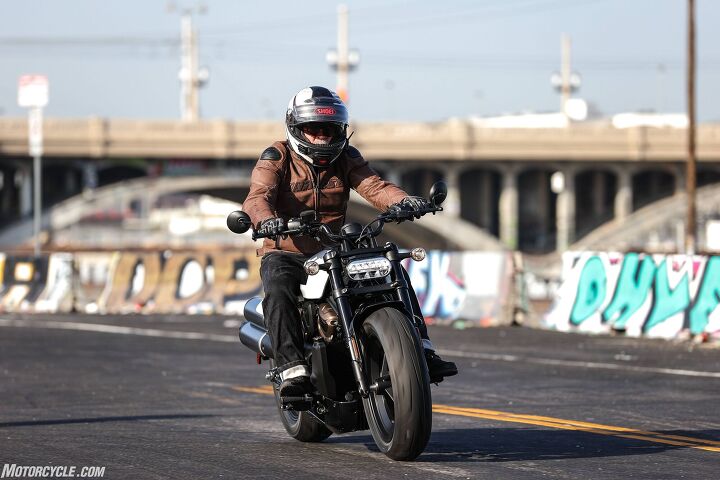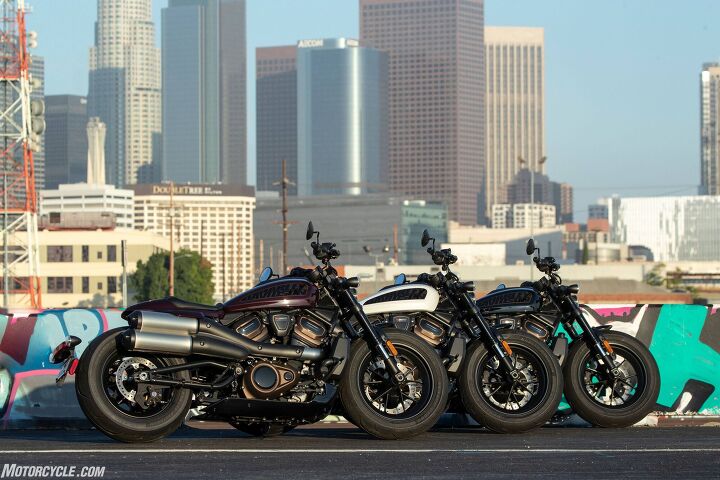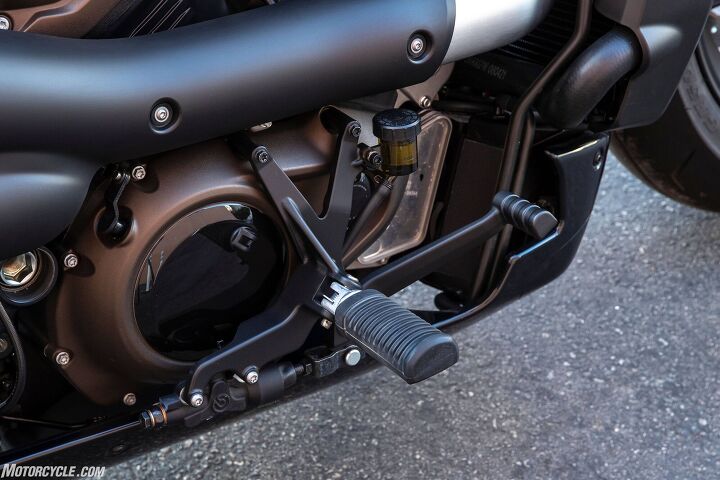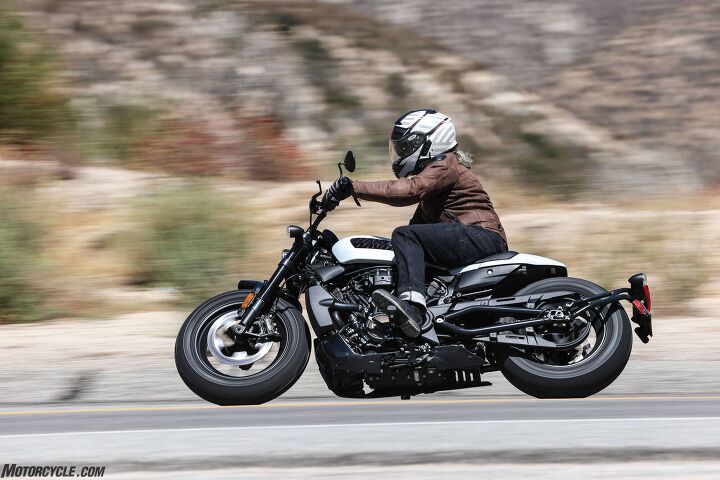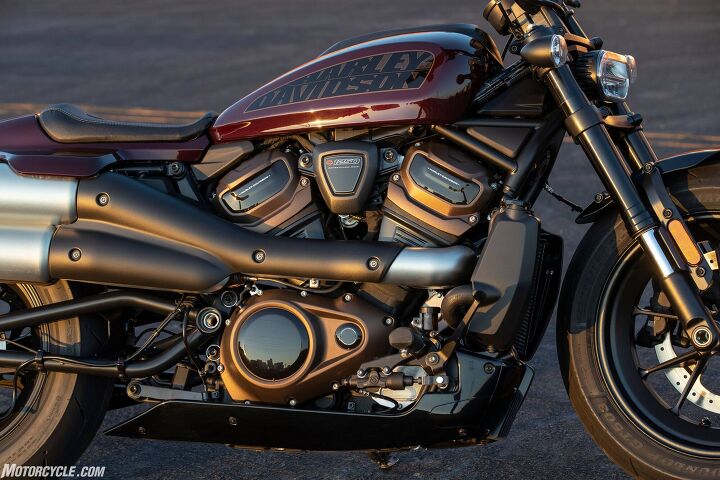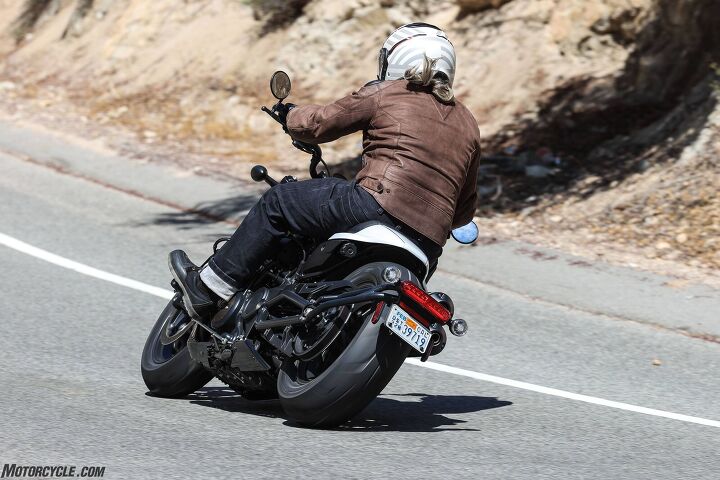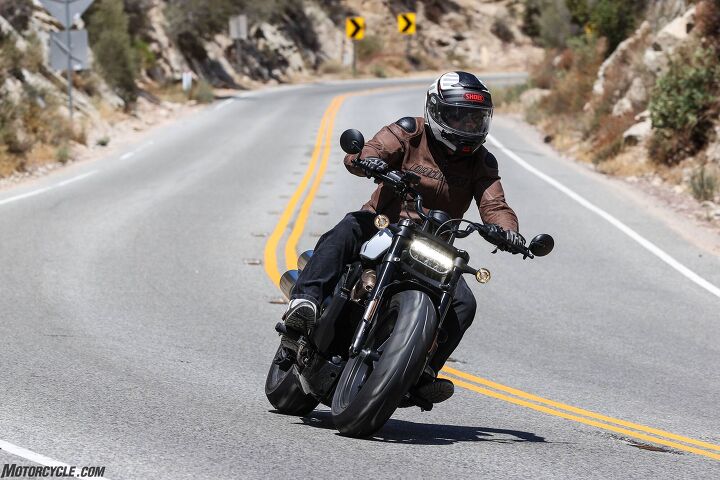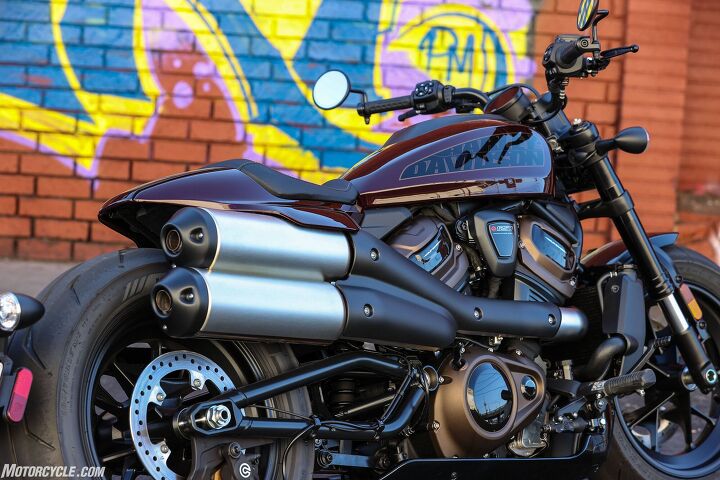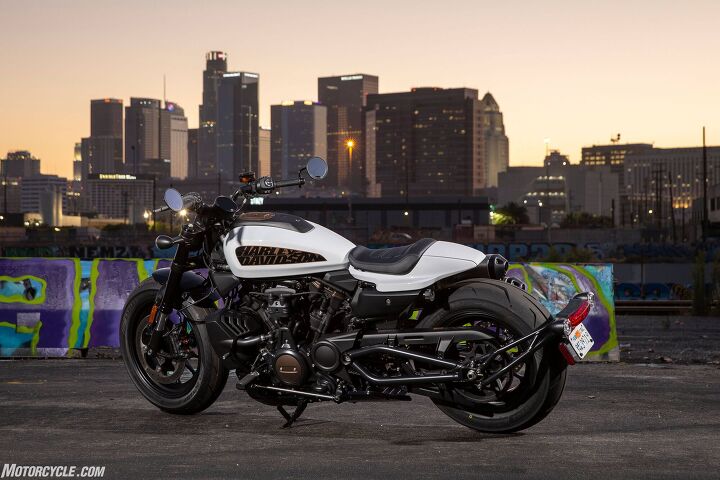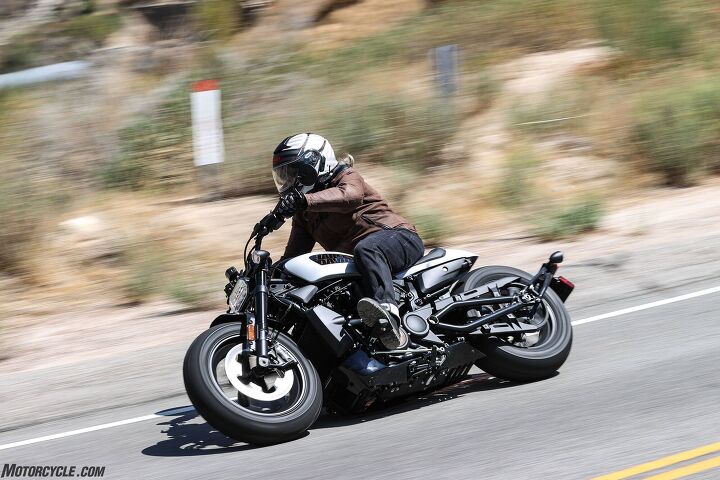Motorsports Racing News & Blog Articles
2021 Harley-Davidson Sportster S Review – First Ride
2021 Harley-Davidson Sportster S
Editor Score: 86.0%| Engine | 19.5/20 |
| Suspension/Handling | 10.0/15 |
| Transmission/Clutch | 8.5/10 |
| Brakes | 8.75/10 |
| Instruments/Controls | 4.5/5 |
| Ergonomics/Comfort | 7.5/10 |
| Appearance/Quality | 9.0/10 |
| Desirability | 9.25/10 |
| Value | 9.0/10 |
| Overall Score | 86/100 |
I learned about a new-to-me thing this week in a fun Facebook discussion: Oppositional Defiance Disorder. This affects lots of kids who are so fed up and angry about being criticized for a thing, that they keep on doing that thing just to own the criticizer, even though they know the thing they’re doing is wrong and bad for them. Before psychology, ODD was probably best expressed as cutting off your nose to spite your face.
I’m pretty sure ODD is why Harley made the decision to give only the third all-new Sportster since 1957 two (2) inches of rear suspension travel. We coastal elite sporty riders have been bagging on certain Harleys for that lack of rear travel forever, so what else should we have expected from the bad, black t-shirt boys of midwestern motorcycledom? Scratch that! It’s worse than we thought. The press kit says 1.5 inches rear travel. Whichever number is correct, and you know we’ll get to the bottom of it ASAP, it’s not enough. [This just in from H-D: Rear shock travel is 1.5 inches. Rear wheel travel is 2.o in.]
Lead Designer Brad Richards owns right up. He wants things to be polarizing. If everybody likes it, says Brad, he’s not doing his job. And he’s completely right, because the whole time we latte sippers have been bagging on Hogs for 2-inch rear-wheel travel (forever), they’ve been the biggest-selling motorcycles in the country. ODD, let’s face it, is just good business. Two inches is how we do it in America, and if we have to explain to you why having your lumbar discs reshuffled over every good-sized bump in the road isn’t the greatest moto experience ever, you wouldn’t understand.
At least it’s a really nice 2 inches of travel, controlled by a single linkage-mounted Showa shock that’s damping-adjustable in both directions, and with a remote preload adjuster you can reach back and twist with your left hand. It’s swell over smooth bumps and nice pavement. When we set out in the morning from the Hotel Figueroa in downtown LA all fresh and eager, it all felt good. Rugged. Tough. Our forebears rode hardtails across the prairie. But by the end of a hot day tearing around bumpy canyons, surface streets, and freeways, my old coccyx was no longer so chipper and neither were the tailbones of the youngsters.
It’s not all the suspension’s fault
The fault does not all lie with the lack of suspension travel. Sharp bumps, big bumps, and serial bumps are all free to have their way with your lower back because your legs aren’t there to defend it by helping to absorb shocks. Oh, no. They’re deployed way out west on the forward-control frontier, where they have nothing to do, really, but display your expensive footwear, trade beads with the natives, and shift gears.
All is forgiven
Luckily, none of that matters. Perhaps subconsciously, Harley knows it has the Oppositional Defiance Disorder, knows it’s been bad, and extends the olive branch to make it all right in the form of the Mid-Control Kit – at a fairly grudging $659.95. “This complete mid-control conversion kit puts the Sportster S motorcycle rider in a more-aggressive foot position for enhanced comfort and cornering confidence. It also reduces the reach to foot controls, an ergonomic advantage for riders of shorter stature.”
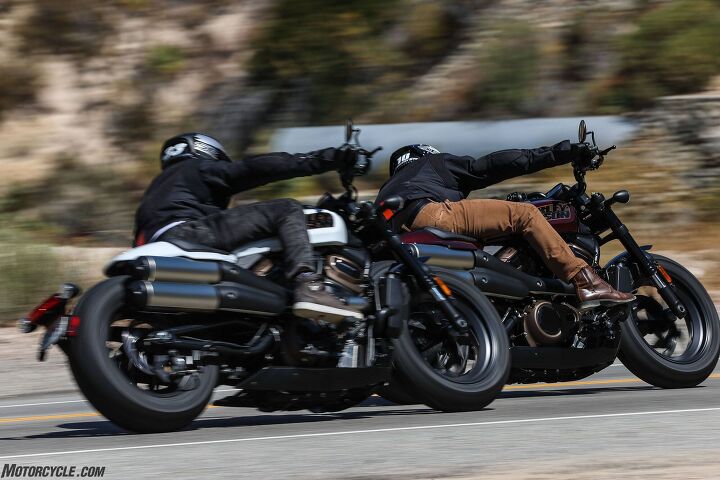
Oh look, it’s King of the Baggers Kyle Wyman and his brother Travis, who are both the same size, giving it the berries on Angeles Forest Highway. Can you tell which one is on the bike with the Mid-Control Kit?
“Shorter stature” in Milwaukee must encompass guys up to 6 ‘2, because the tallest guy on our ride much preferred the mid controls also, along with just about everybody else except our H-D reps, who insist the mid-mount footpegs feel cramped to them. Odd, isn’t it? In a perfect world of smooth pavement, they’d have a wobbly leg to stand on. In our bumpy one, the mid controls not only let you use your legs to help the suspension, they also increase the sportiness of the motorcycle by about a factor of 2.3, allowing you to move around on it more freely and weight the pegs as needed. (A conspiratorial-minded person would surmise, probably on Facebook, that it’s all designed to sell a shedload of Mid Control Kits at $660 each.)
Two of our test fleet of about 10 or 12 new Sportsters had the mid controls, and I didn’t have to ride one of them far at all to see the light. They even let you stand up from the thinnish seat to air your undercarriage out as needed, a thing nearly impossible with the forward pegs.
Putting the Sport back into Sportster
They really did. For one thing, it scoots. Guys who’d also ridden the Pan America said they didn’t really notice the only-121 peak horsepower of the Sportster compared to the claimed 150 of the PA. That’s because there’s so much power packed in the lower part of the rev range you never get to 9000 rpm on the street. Hardly ever. With the variable valve timing and the Revolution Max’s “T” state of tune, by the time the electronic tach needle swings past about 4000 rpm, you best be holding on tight – especially in Sport mode, where the engine delivers the same kind of low-rpm whomp we love in the Indian FTR1200, and even a bit more. The claim is 94 lb-ft of torque at 6000 rpm, which feels entirely believable (probably 79 lb-ft at the rear wheel, says my butt dyno). If you went drag racing you’d miss the extra top end of the non-T Rev Max. Everywhere else, not at all on the unfaired Sportster. If you must wheelie, the new Sportster is your friend; the traction control contains a Front Wheel Lift Mitigation program, which can be adjusted for height and duration or turned off.
Soundwise, you could also mistake the Rev Max T for a really powerful Ducati: The 60-degree V angle and 30-degree offset crankpins give the Sportster a confident rhythm it never had before, while a pair of counterbalancers keep it really smooth, too. At idle, the front wheel does not jump back and forth; potato-potato is no more.
When the light turns green, the Sportster dispatches all traffic with ease even after you dial it back to Road mode (easy to do even on the fly with your right thumb) for less aggressive power delivery. Critical people might say throttle response is a bit abrupt in Sport mode; for some of us the abruptness is kind of the point.
Where it matters, driving out of corners leaned over in the mountains, is never problematic. The rear tire’s fat contact patch has a grip on the situation, and when it doesn’t the bike’s IMU and traction control do. Rolling on and off the throttle results in nothing but smooth power delivery and a surprising amount of thrust. Again thanks to the VVT, you can leave the engine in a higher gear and roll through corners at 4000 rpm or so, or downshift and blast out. The six-speed gearbox works fine; primary drive via scissors gear, and belt drive, keep lash to a minimum. A nice quickshifter would be sublime. It’s strange that a Sportster has you thinking quickshifter thoughts instead of railroad coupler ones. For God’s sake man, the Sportster S even comes with regular-diameter motorcycle grips instead of the thick ones Sportsters have always used to better display one’s LOVE/HATE knuckle tattoos.
Light weight
Then there’s the lightness of the new package: 502 pounds wet is 62 less than the old-school 2021 Iron Sportster 1200, and 59 less than Indian’s Scout spec. A lot of that weight reduction is down to the elimination of the old steel cradle frame, replaced now by front and rear frame sections bolted directly to the new engine. And that new engine was on a careful diet from the start, packed with things like single-piece aluminum cylinders lined with nickel silicon-carbide galvanic coating, and magnesium rocker, camshaft, and primary covers. The kickstand’s a tad on the short side, but it’s still easy to pick the bike up off it.
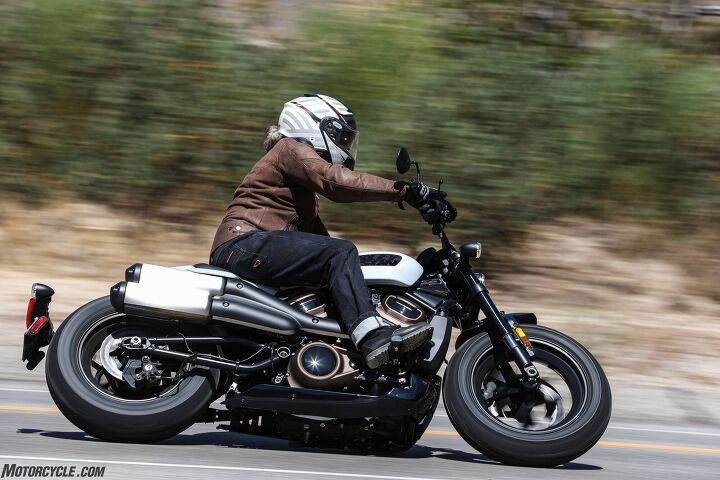
The claim is 34 degrees of lean on both sides; it feels like plenty fast enough for me on the street when the peg feelers send up the warning.
Rubber, meet road
All that adds up to a package that has you carving corners at a very respectable rate and angle of attack before the footpeg feelers begin suggesting you should cool your jets. For one thing, the new chassis and suspension at both ends are far superior to the previous Sportster.
And if you were worried those fat tires were going to jack up the handling, you needn’t have. These Dunlops were built for the Sportster S, and the front in particular has a pointier profile than usual that lets the bike roll into and around corners in a completely normal-feeling way.
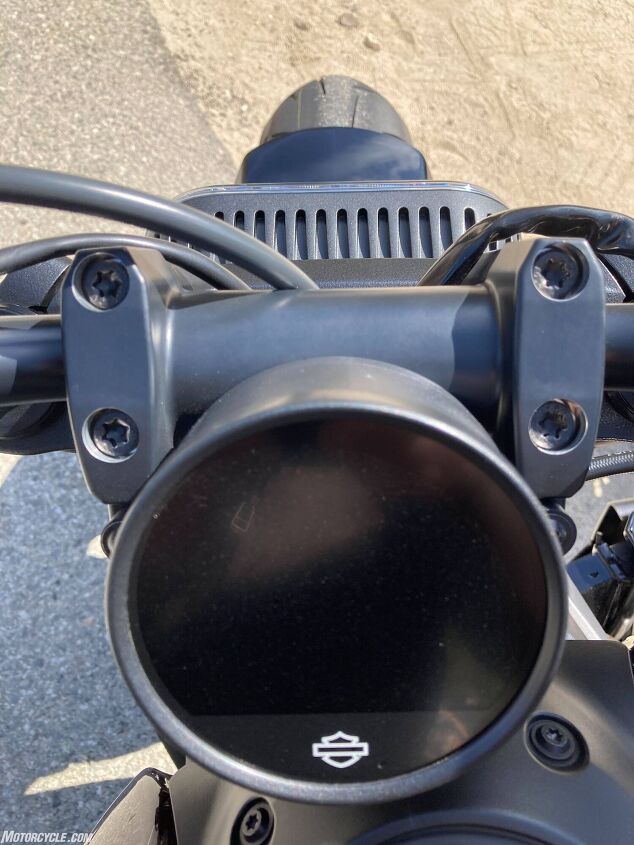
Brad Richards said they wanted a bike to disappear beneath you: Looking at the front tire from the saddle, I kept thinking Beldar Conehead had disappeared beneath me.
Braking midcorner doesn’t cause the bike to want to stand up or turn in; it remains neutral. And in fact, the fatness of the front tire gives it a bigger contact patch that feeds back more road feel than most motorcycles give you: It’s fun to bend the Sportster into fast corners with the brakes on. What could go wrong, now that you’ve got lean-sensitive ABS? If those big tires increase steering effort a smidge, it seems worth it for the increased gyro stability they provide, especially on the mostly fast roads we rode.
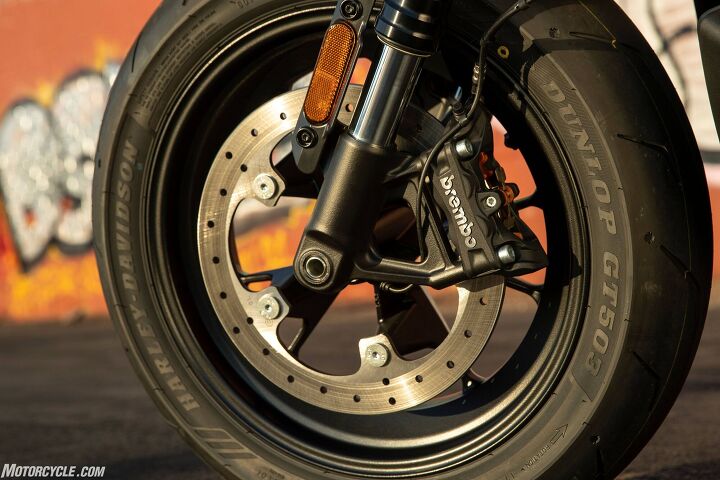
One 320mm disc, mounted to the spokes, is more than enough to get the fat front Dunlop howling with two fingers, thanks to the custom Brembo four-pot caliper/radial master cylinder braking cocktail. Strong but sensitive, it enjoys trailbraking and movie nights in the garage.
Heat control
Another thing I was worried about on my way to LA was how hot was that stainless steel exhaust going to be? The happy answer is it’s not bad at all. The catalyzer is tucked as low and rearward as possible, and a few layers of various kinds of high-tech insulation mean that even with your inner pants leg touching the outermost black plastic shield when stopped, it’s warm but not hot. It also sounds louder than 80 dB, but we know H-D always follows the letter of the law.
There’s a new 7.6-liter airbox under the gas tank with a pair of tuned velocity stacks and internal ribs that Harley says quell intake noise, leaving more leeway for the newly tasteful exhaust racket.
The rear cylinder puts out more heat than the light, 304-series stainless steel exhaust system, but it’s not bad at all even sitting in traffic on a 100-degree day; we also get rear cylinder deactivation. Brad Richards says he was amazed and happy the high exhaust made it from early planning through to production, even though it required ditching the dual shocks. Win/win. He also says the modular construction of being able to bolt things onto the front and rear of the engine opens up many more possibilities than the old steel-framed Sportster allowed.
Speaking of the law, various manufacturers over the years have explained away big ugly fenders by telling us there’s a federal requirement. The shorty fenders on this one means when it rains, you get wet from the front and the rear tires. We’re in a megadrought in California; we care not. If you do, we’re told the Passenger Pillion Kit has a rear fender extension which addresses water coming in over the stern.
Electronic niceties
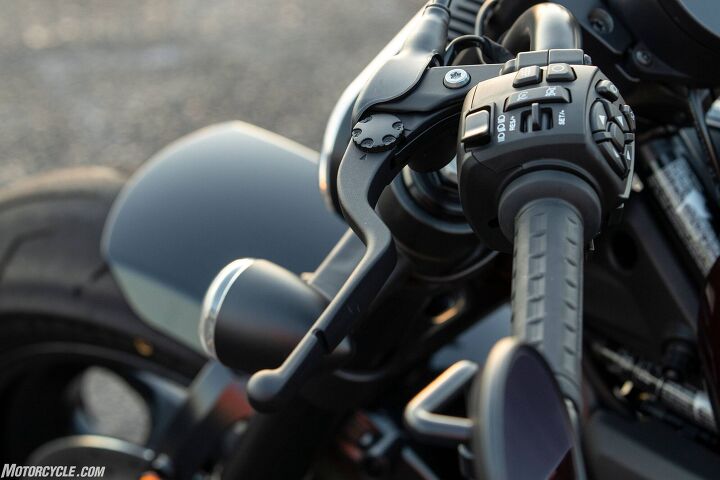
Brake and clutch levers are both adjustable. Standard heated grips too, with dedicated button right there. Note also the regular-diameter motorcycle grips instead of the usual H-D fatties. Much better.
The Sportster S had me at standard electronic cruise control, but it’s also got tire pressure monitoring and all the modern Bluetooth stuff people want: Display your phone’s directions or download Harley’s navigation app, shuffle through your music with the handlebar buttons, ID who’s calling and all that.
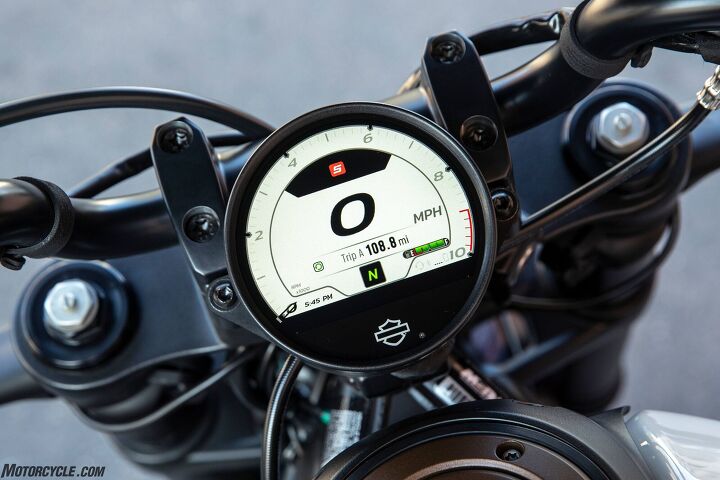
You can rev the Revolution Max T to 9000 rpm, but you seldom do, there’s so much acceleration available anytime above 4k. It’s already my favorite H-D motor after one day. We cheaped out a smidge with a steel handlebar instead of an aluminum one. Inverted 43mm Showa fork is fully adjustable.
Bold new world
It’s a completely new motorcycle that has almost zero in common with the outgoing Sportster, but the design and engineering teams knew (along with everybody else on the planet) that they needed to retain some Sportster character. Because, you know, Oppositional Defiant Disorder. It’s a shame they mostly kept some of the worst Sportster characteristics, but there it is: There’s not enough wheel travel out back, and forward foot controls are not as good for most people. But we all know this is how it had to be to appease the H-D base, and the solution to the problems for the rest of us, like we said up front, is already standing by in Parts & Accessories.
Even we coastal elites have to admire the long, low rake of the thing, basking there in the setting sunlight. You have to admit that the Sportster profile, even with all-new components including radiator and a couple of unobtrusive hoses, remains intact and distinct. And it really is nice to be able to swing a leg over it without throwing out a hip when you’re a paunchy 5’8, and to plant both feet firmly on American soil. Makes you feel tall, patriotic even. This we’ll defend. Death before Depends.
Furthermore, the Sporty doesn’t have a hair out of place, nor an exposed wiring connector nor a visible hardware store fastener. Lessons learned by the failure of an entry level model or two in the last decade were not lost on the current H-D regime. Enough said.
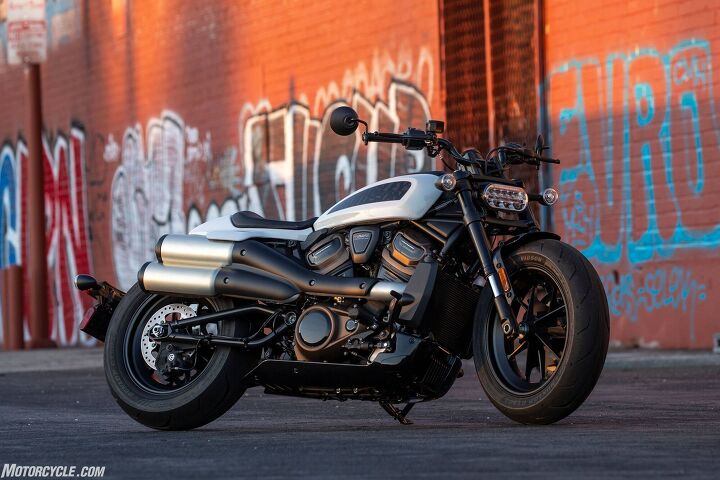
All LED lighting includes this cool Daymaker, “designed to produce a homogenous spread of light while eliminating distracting ‘hot spots.’” The bar-end mirrors work great even if you’re thick.
But it’s really all about the motor
While the crowd was gazing on in admiration, Brad and Kyle Wick and the engineering team slid in a fantastic new ripsnorter of an engine that’ll save you the price of a longer rear shock the first time it doesn’t need a valve adjustment, thanks to the hydraulic lifters. Not only is it stupid-fast in the part of the powerband where you can most appreciate it, it’s also smooth-running and docile in the non-Sport modes, not too hot between your thighs – and it better get close to H-D’s 49 mpg claim, or the 3.1-gallon tank is too small. In fact, the tank’s still too small, but ODD.
I only rode the bike for one day, so don’t hold me to this. But I think the Revolution Max might not just be my favorite Harley engine, it might be my new favorite motorcycle engine. And the rest of the new Sportster S isn’t far off the pace, including its standard cruise control. I take back all the nasty things I’ve said about lame Sportsters over the years. This one makes up for all of them, and it only took H-D 30-some years to get it right.
| 2021 Harley-Davidson Sportster S | |
| + Highs Revolution Max T is a staggering work of genius Excellent heat and NVH control (Noise, Vibration, Harshness) Light weight, low seat | – Sighs 2-inch rear wheel travel Mid Controls should be a no-cost option 3.1-gallon tank is too small for a bike this nice with cruise control |
|
In Gear
|
| 2021 Harley-Davidson Sportster S Specifications | |
|---|---|
| Engine | Revolution Max 1250T |
| Valves | Chain-driven, DOHC, hydraulic self-adjusting lifters, intake & exhaust VVT; four valves per cylinder |
| Bore | 4.13 in. (105 mm) |
| Stroke | 2.85 in. (72.3 mm) |
| Displacement | 76.4 cu in (1,252 cc) |
| Compression Ratio | 12.0:1 |
| Horsepower | 121 hp at 7500 rpm (claimed) |
| Torque | 94 lb-ft. at 6000 rpm (claimed) |
| Fuel System | Electronic Sequential Port Fuel Injection (ESPFI) |
| Air Cleaner | Downdraft intake, tuned velocity stacks, washable filter media |
| Exhaust | 2-into-1-into-2; catalyst in muffler |
| Lubrication System | Semi-Dry Sump |
| Primary Drive | Gear, 49/89 ratio |
| Final Drive | Belt, 80/34 ratio |
| Clutch | Mechanical, 8 plate wet, assist & slip, 1090N |
| Transmission | 6-speed |
| Frame | Stressed-member, high strength low alloy steel trellis frame; stamped, cast, and forged junctions; MIG welded; aluminum forged mid-structure |
| Swingarm | High strength low alloy steel, tubular sections, stamped x-member, forged axle junctions; MIG welded |
| Front Fork | 43 mm inverted fork with compression, rebound and spring preload adjustability. Aluminum fork triple clamps. 3.6 inches of travel. |
| Rear Shocks | Linkage-mounted, piggyback monoshock with compression, rebound and hydraulic spring preload adjustability. 2.0 inches of travel. |
| Wheels, Front Type | Aluminum cast, satin black |
| Wheels, Front Width | 4.5 in. (114 mm) |
| Wheels, Front Height | 17 in. (432 mm) |
| Wheels, Rear Type | Aluminum cast, satin black |
| Wheels, Rear Width | 5 in. (127 mm) |
| Wheels, Rear Height | 16 in. (406 mm) |
| Front Brake | Radially mounted, monoblock, 4-piston caliper, 320 mm disc. |
| Rear Brake | Floating, single piston caliper, 260 mm disc |
| Brakes, Anti-Lock Braking System (ABS) | Standard |
| Lean Angle | 34° left and right |
| Fuel Economy | 49 mpg (4.8 l/100 km) (claimed) |
| Lights (as per country regulation), Headlamp | All LED headlamp, low and high beam with signature position lighting |
| Lights (as per country regulation), Tail/Stop | All LED Tail/Stop lamp with signature tail lighting |
| Lights (as per country regulation), Front Signal Lights | LED Bullet Turn Signals |
| Lights, Rear Turn Signals | LED Bullet Turn Signals |
| Gauges | 4 inch viewable area TFT display with speedometer, gear, odometer, fuel level, clock, trip, ambient temp, low temp alert, side stand down alert, TIP over alert, cruise, range and tachometer indication BT capable – phone pairing to access phone calls, music, navigation (H-D App ONLY) |
| Electric Power Outlet | USB C-Type , Output 5V at 2.4 Amp |
| Length | 89.2 in. (2,265 mm) |
| Overall Width | 33.2 in. (843 mm) |
| Overall Height | 42.9 in. (1,089 mm) |
| Seat Height, Laden | 28.9 in. (734 mm) |
| Seat Height, Unladen | 29.6 in. (753 mm) |
| Static Ground Clearance | 3.66 in. (93 mm) |
| Rake (steering head) (deg) | 30° |
| Fork Angle (deg) | 28° |
| Trail | 5.8 in. (148 mm) |
| Wheelbase | 59.8 in. (1,518 mm) |
| Front Tire | Harley-Davidson Series, radial Dunlop GT503 160/70TR17 73V |
| Rear Tire | Harley-Davidson Series, radial Dunlop GT503 180/70R16 77V |
| Fuel Capacity | 3.1 gal. (11.8 l) |
| Reserve Fuel Capacity, Fuel Injection (warning light) | 0.8 gal. (3 l) |
| Oil Capacity (w/filter) | 4.75 qt. (4.5 l) |
| Weight, In Running Order | 502 lb. (228 kg) (claimed) |
| Warranty | 24 months (unlimited mileage) |
| Service Interval | First 1,000 miles (1,600 km), every 5,000 miles (8,000 km) thereafter |
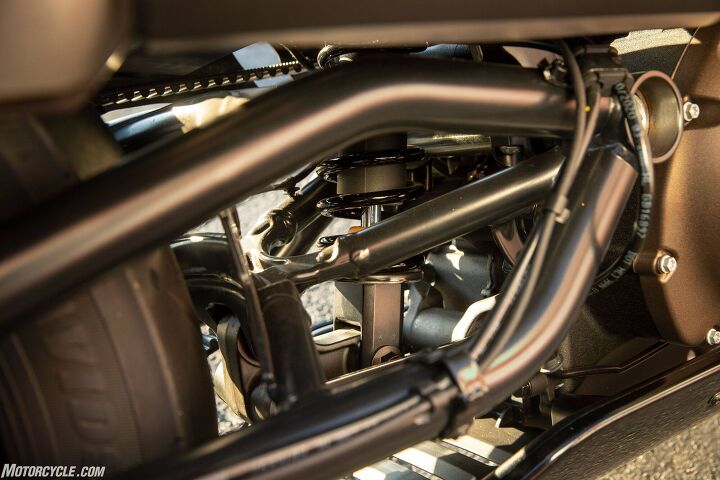
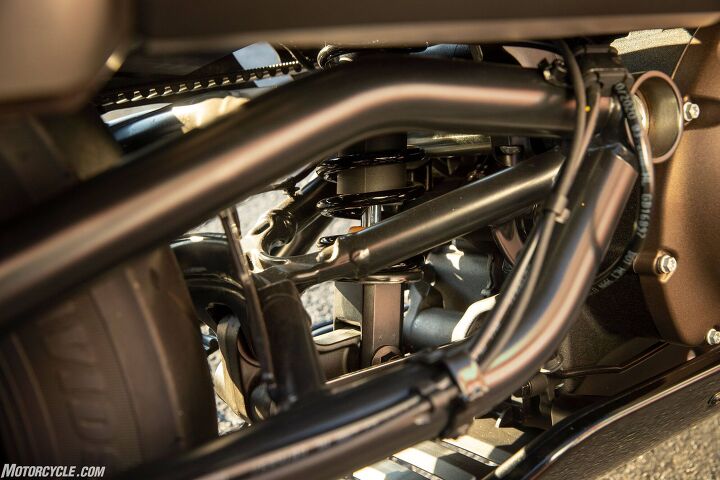
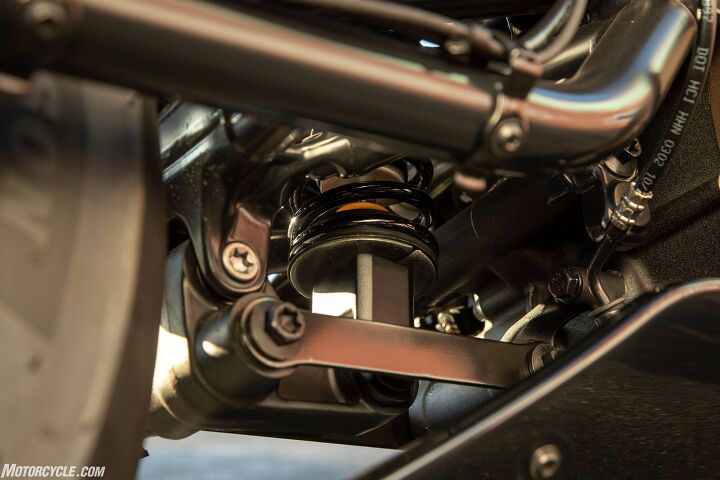
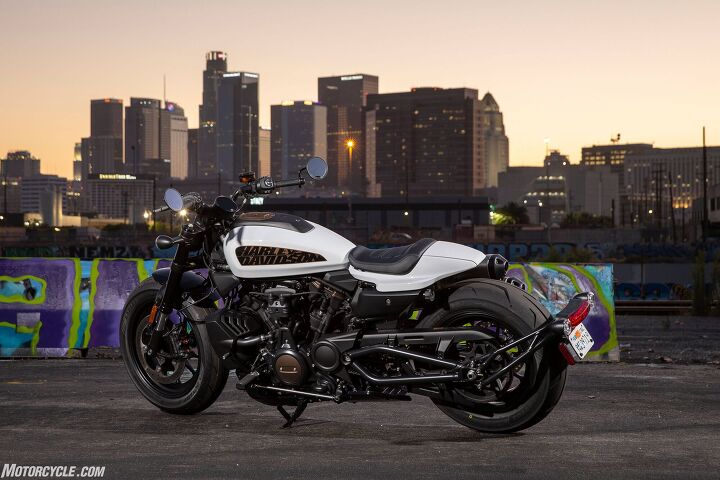
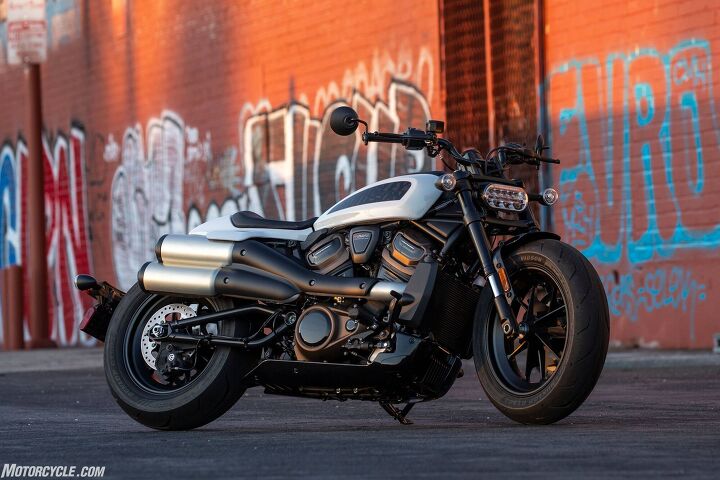
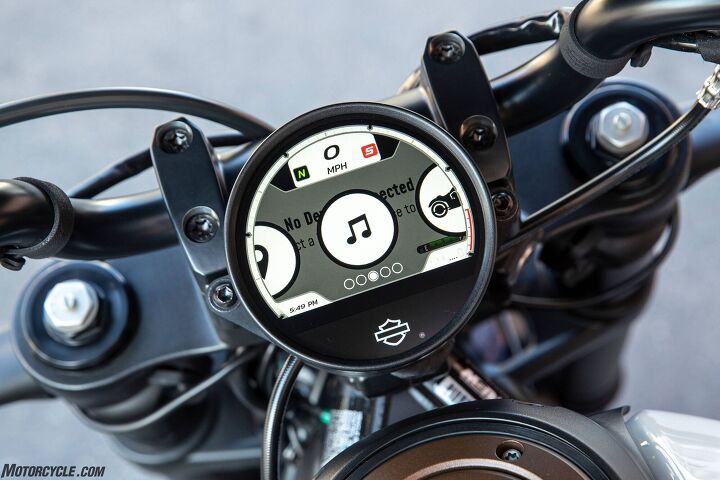
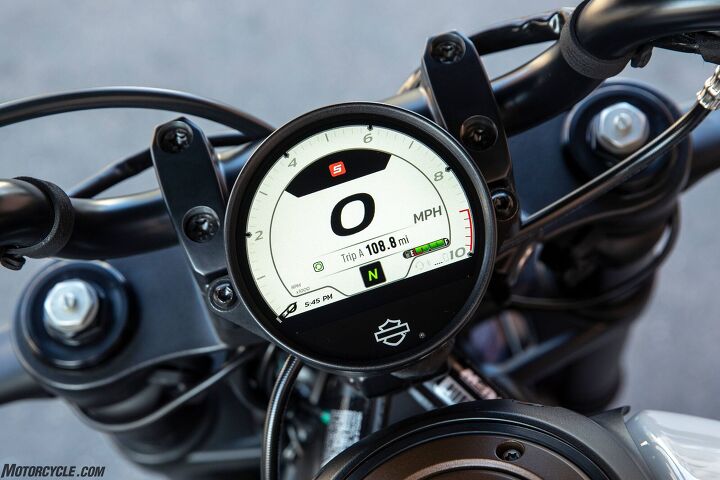
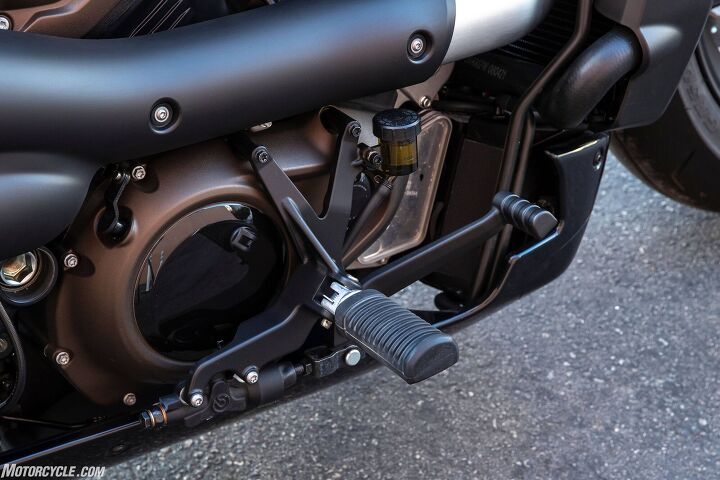
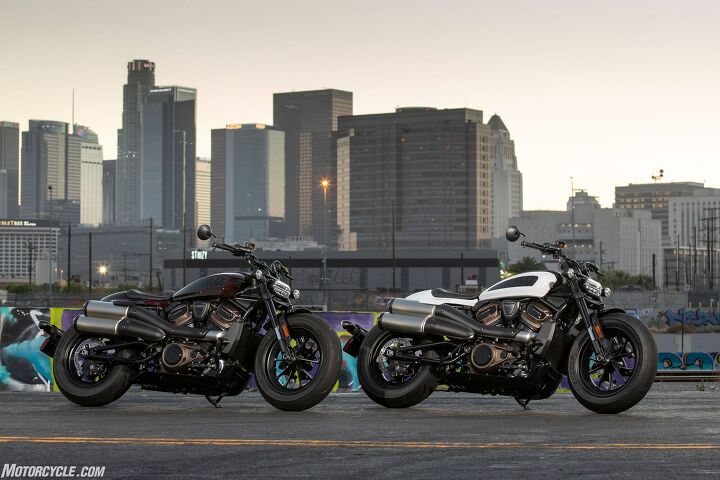
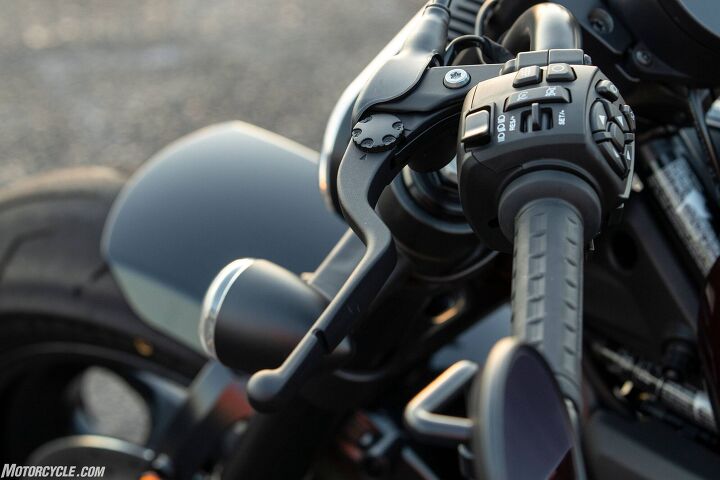
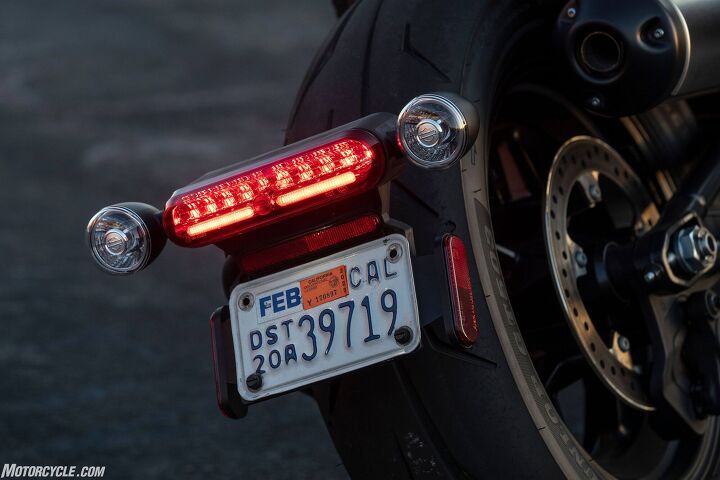
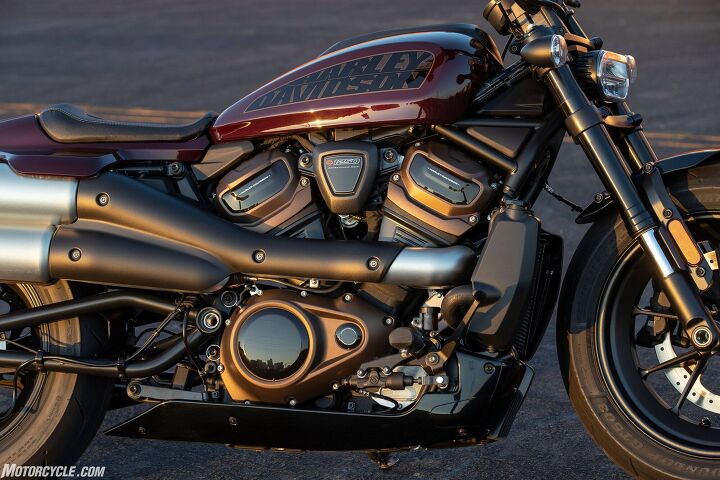
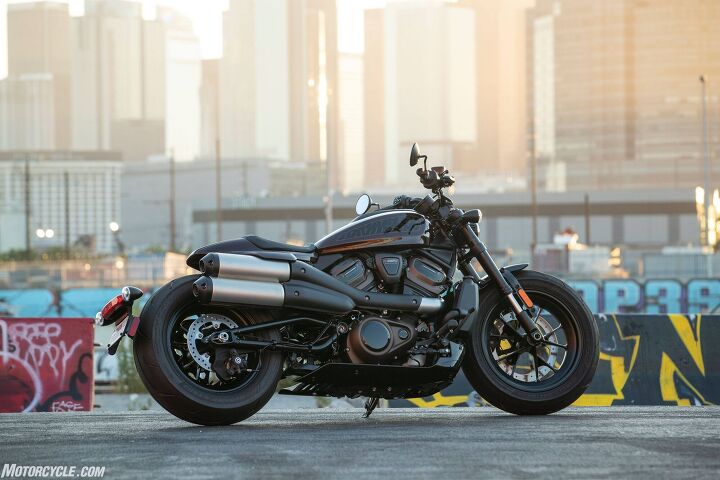
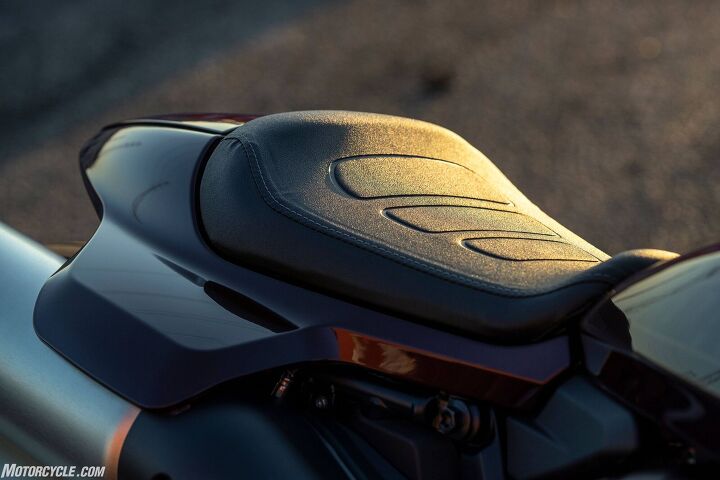
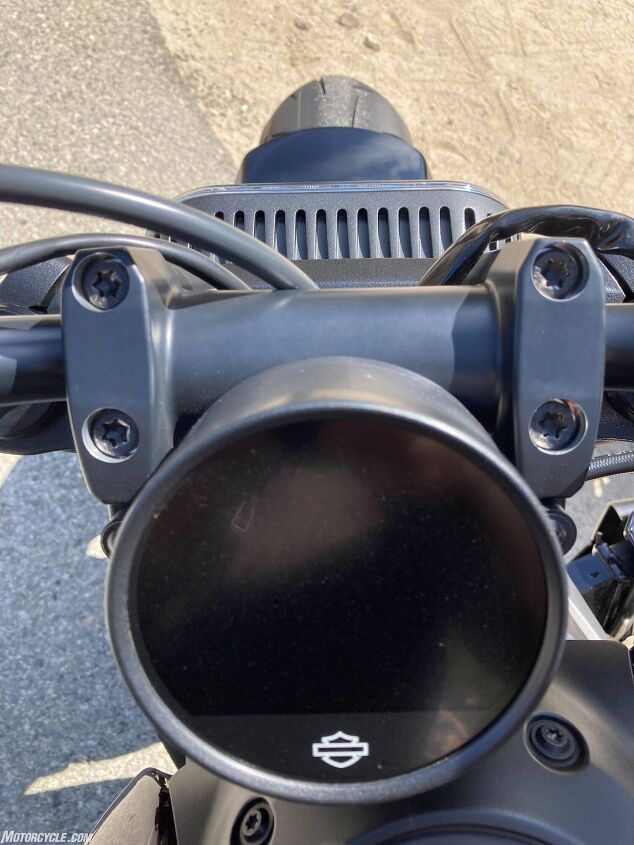
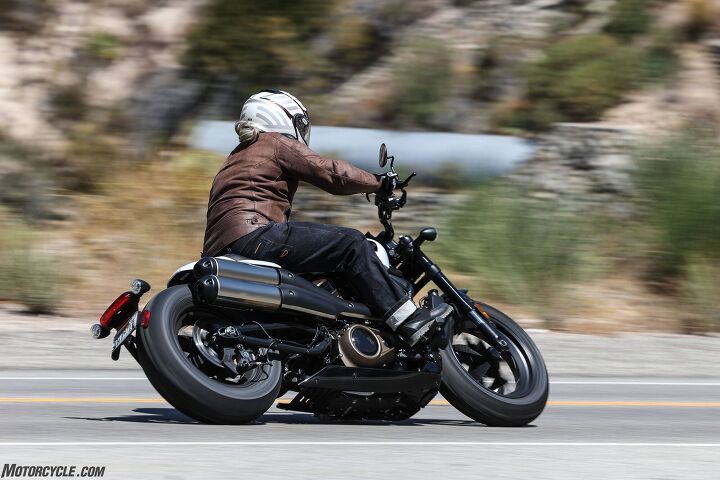
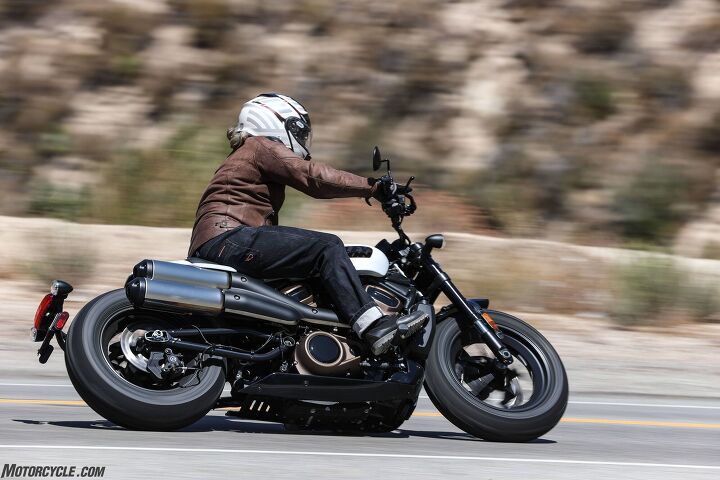
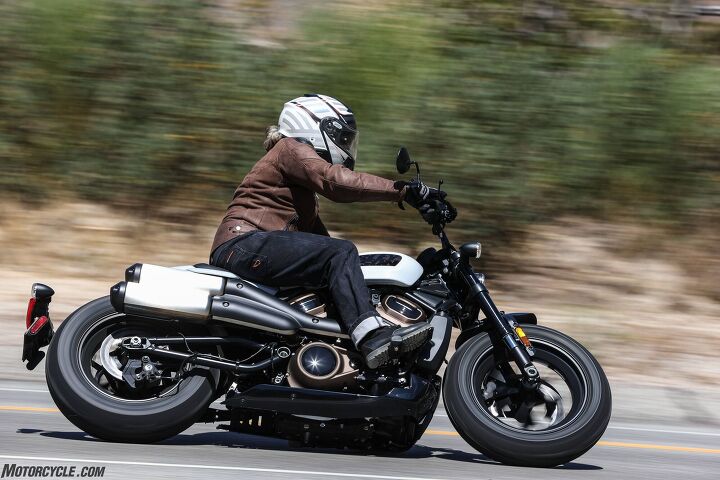
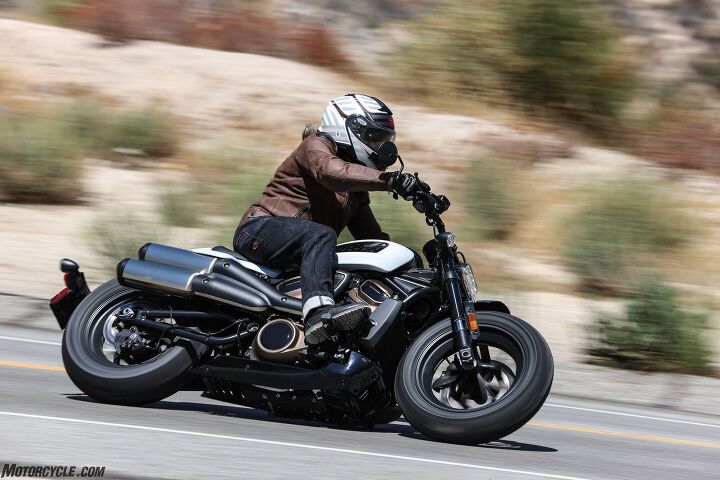
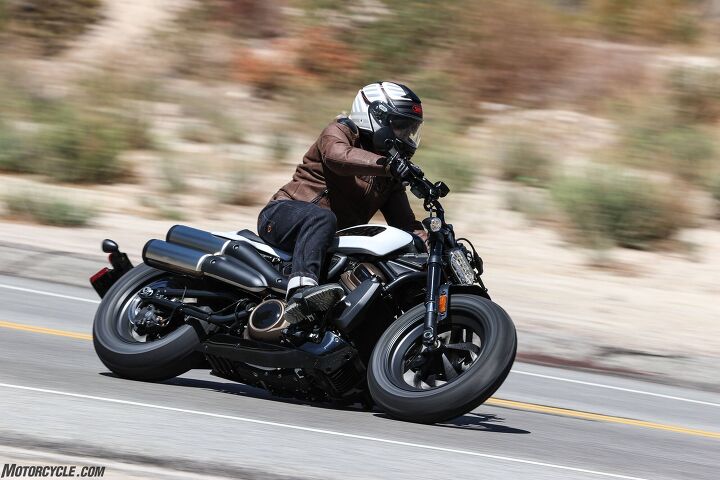
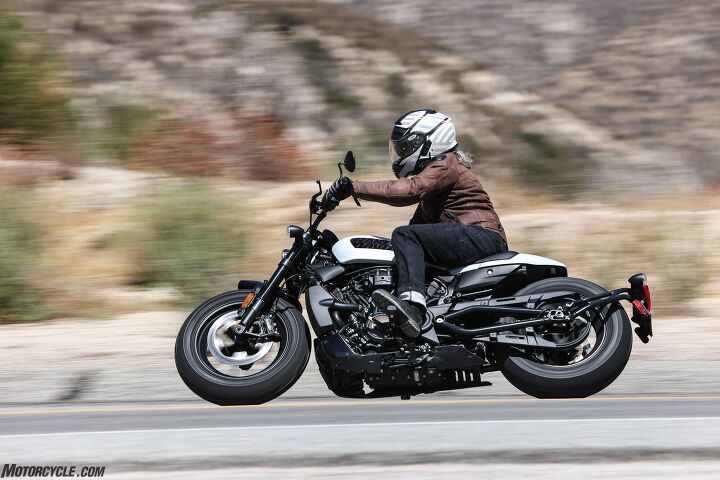
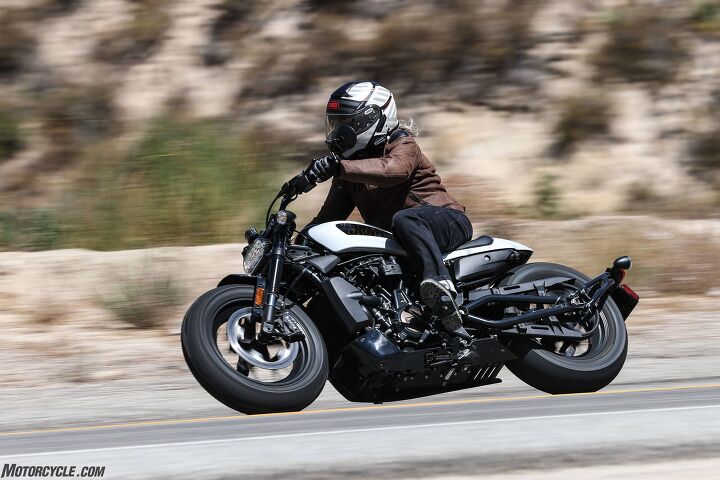
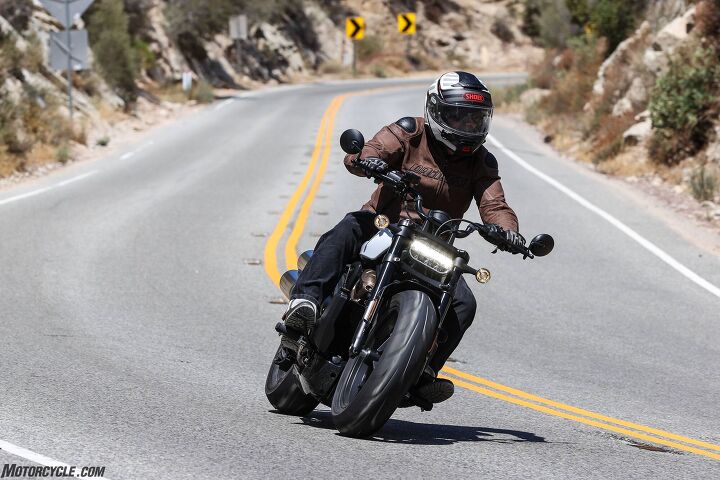
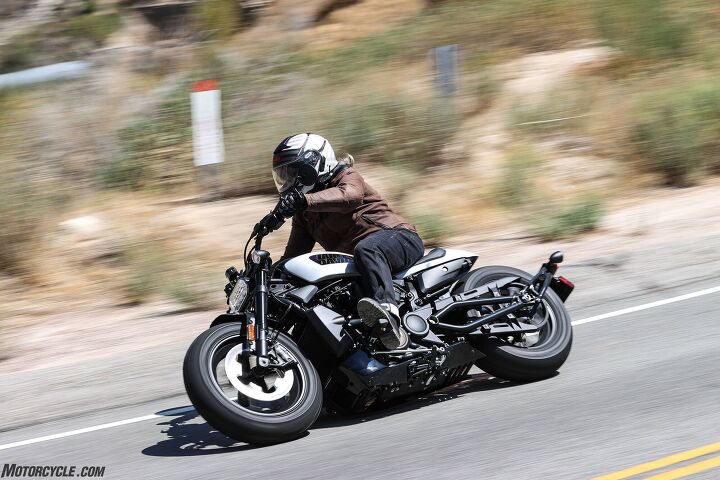
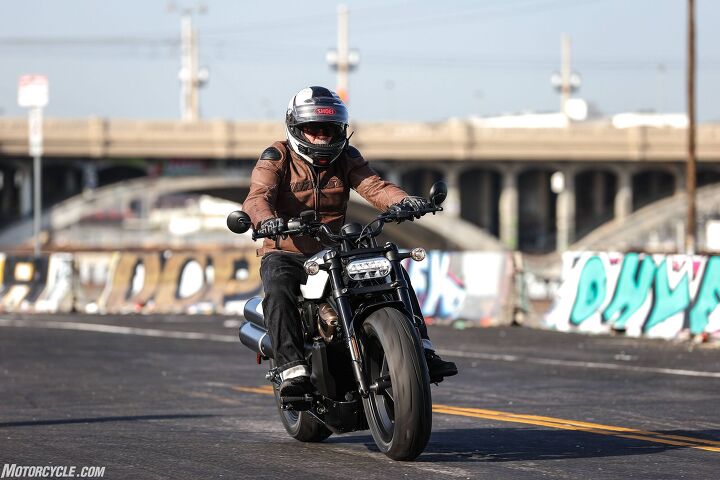
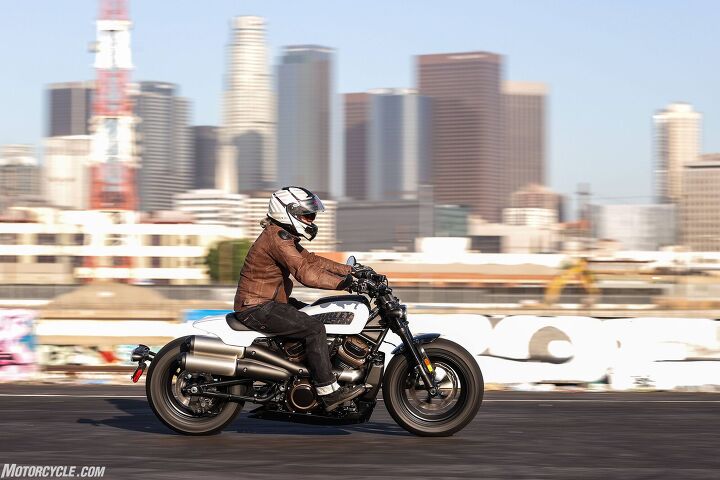
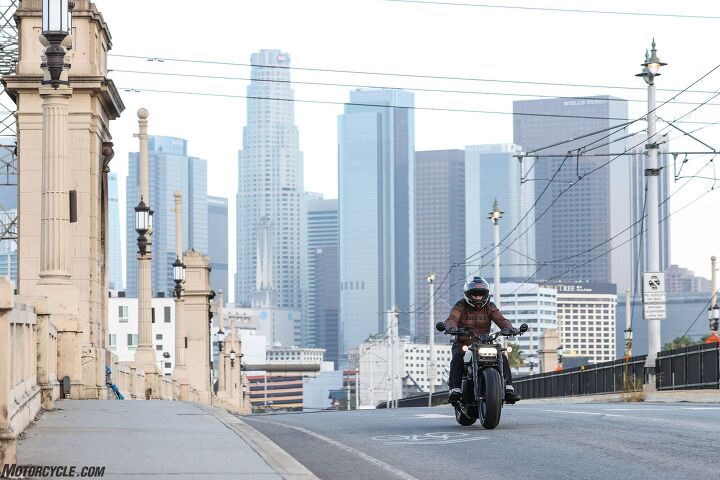
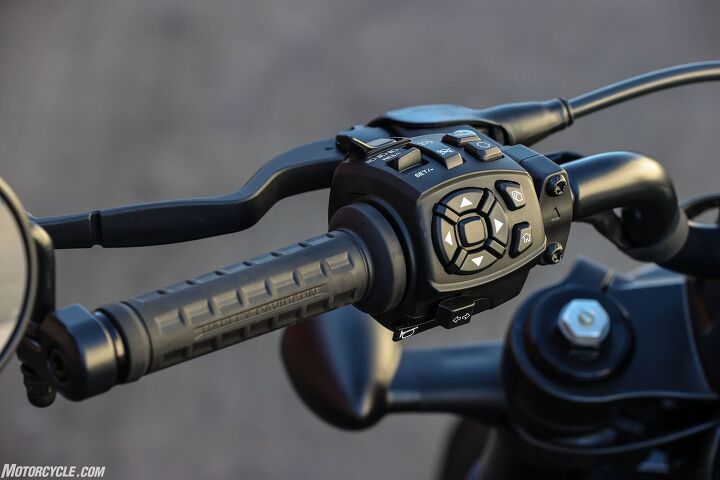
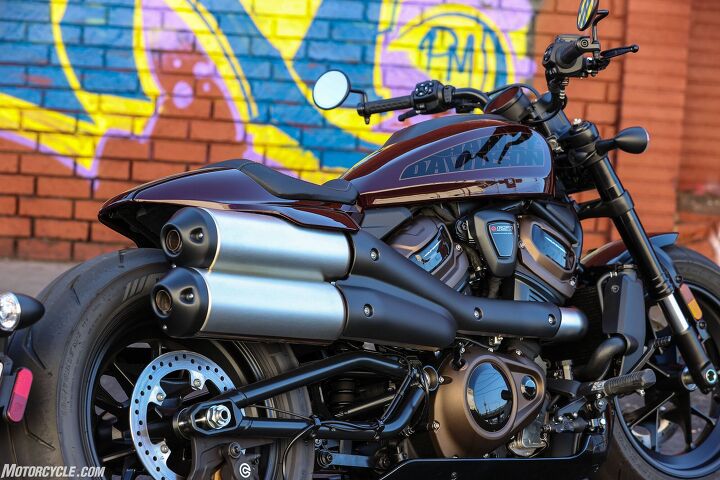
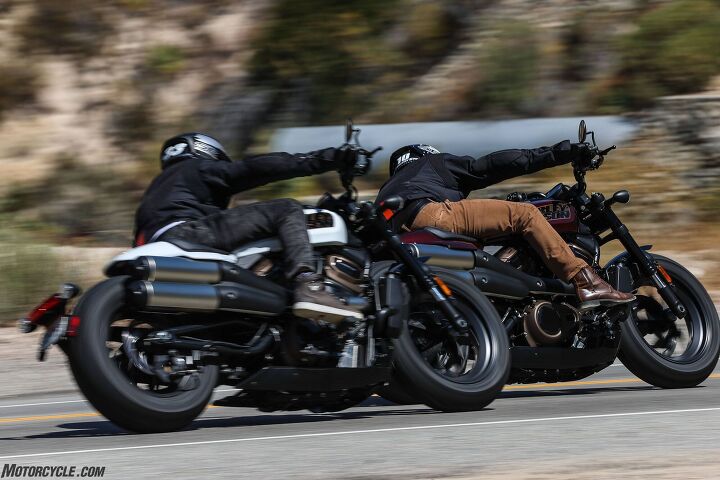
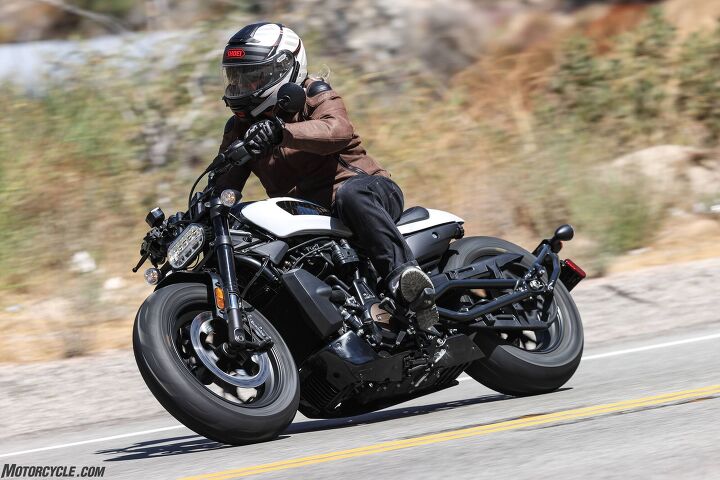
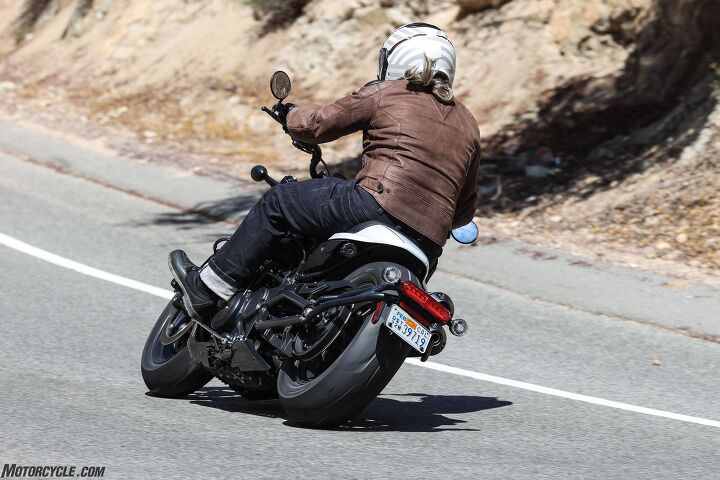
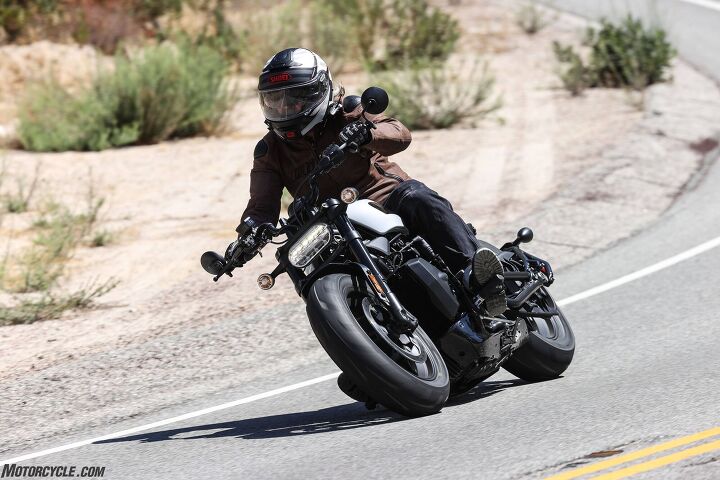
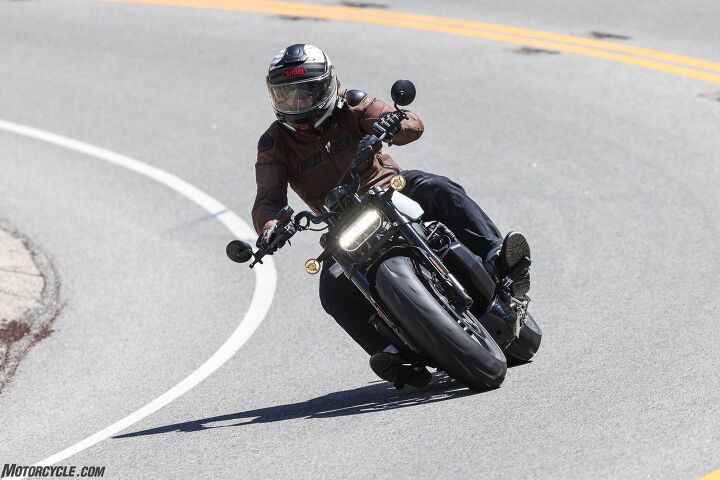
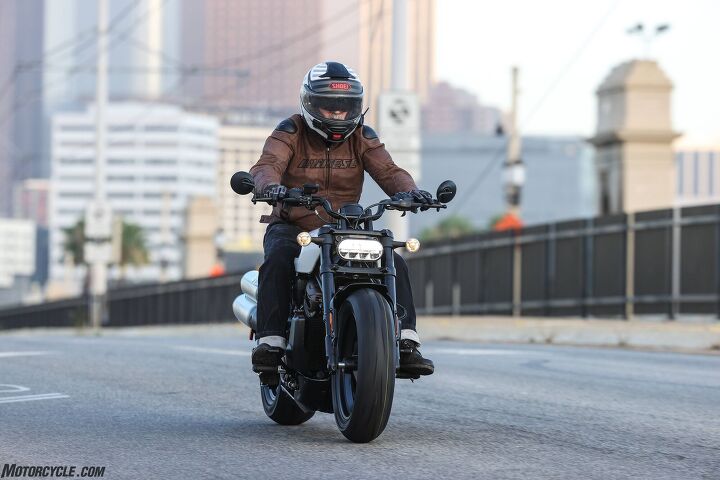
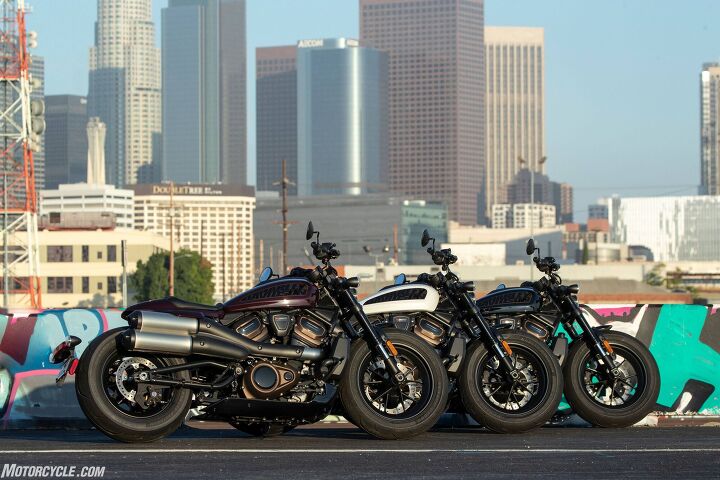
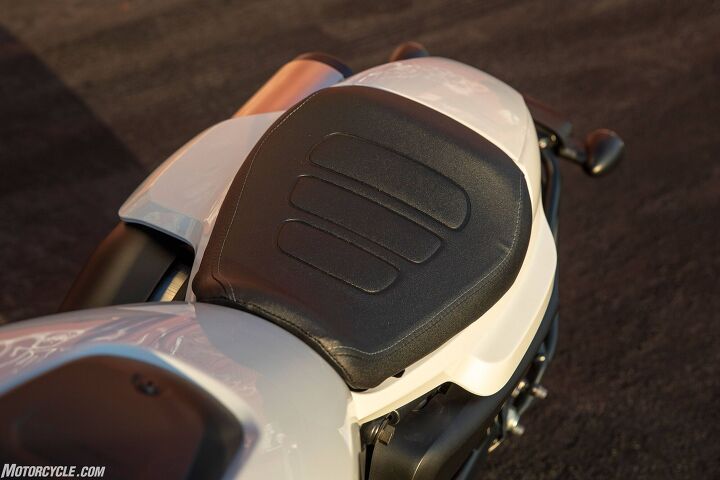
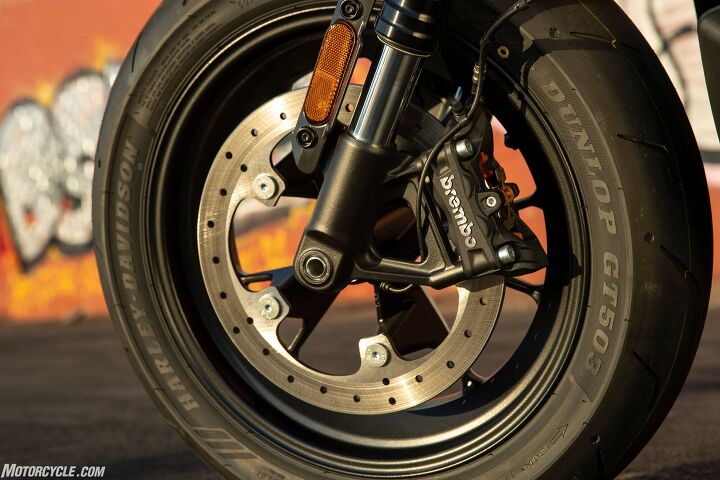
We are committed to finding, researching, and recommending the best products. We earn commissions from purchases you make using the retail links in our product reviews. Learn more about how this works.
Become a Motorcycle.com insider. Get the latest motorcycle news first by subscribing to our newsletter here.
The post 2021 Harley-Davidson Sportster S Review – First Ride appeared first on Motorcycle.com.
Copyright
© Motorcycle.com


